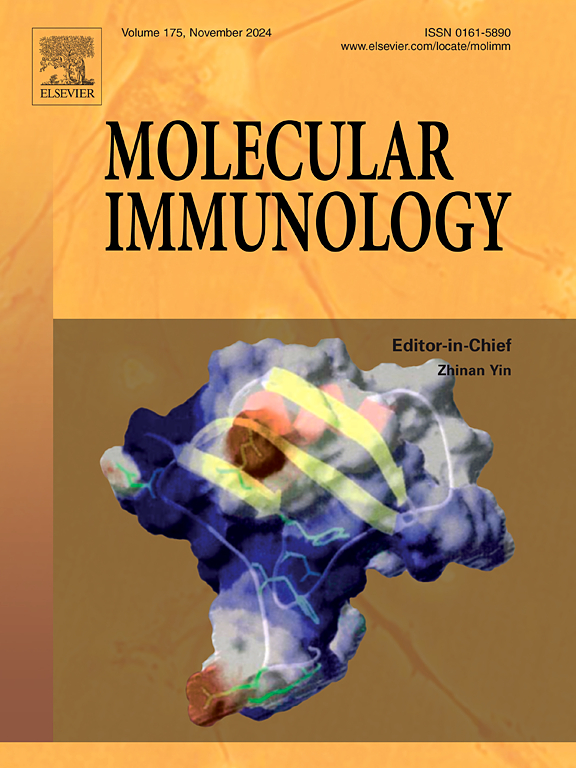SAA1 deletion ameliorates cardiac injury after myocardial infarction by promoting macrophage transformation to reparative subtype
IF 3
3区 医学
Q2 BIOCHEMISTRY & MOLECULAR BIOLOGY
引用次数: 0
Abstract
Background
The regulation of M1/M2 macrophage phenotypic conversion is an effective therapeutic strategy for post-myocardial infarction (MI). Serum Amyloid A1 (SAA1) is an acute-phase protein that plays an important role in regulating inflammatory responses. However, its function in modulating macrophage polarization post-MI remains unclear.
Methods
To achieve macrophage-specific manipulation of SAA1 expression in vivo, adeno-associated virus 9 (AAV9) vectors driven by a macrophage-specific promoter (F4/80) were used to either knockdown (AAV9-F4/80-sh-SAA1) or overexpress (AAV9-F4/80-SAA1) SAA1. Two weeks after the virus injection, mice underwent MI and ischemia-reperfusion (I/R) surgery. Each group included six mice. Immunofluorescence (IF), western blotting, and quantitative real-time polymerase chain reaction were performed to explore the mechanisms underlying SAA1-induced macrophage polarization and cardiac injury after MI and I/R. SAA1 was overexpressed and knocked down in lipopolysaccharide-stimulated bone marrow-derived macrophages in vitro using plasmids and siRNA. IF, western blotting, and quantitative real-time polymerase chain reaction were used to measure macrophage polarization and inflammatory responses.
Results
We detected a significant increase in SAA1 levels in human and mouse peripheral blood mononuclear cells after MI and I/R. Following SAA1 knockout, left ventricular ejection fraction (64.33 ± 2.35 % versus 40.97 ± 8.36 %) was significantly improved and infarcted size (93.95 ± 3.79 % versus 29.76 ± 17.05 %) was markedly reduced in MI+AAV-9-F4/80-Sh-SAA1 compared with MI+AAV-9-F4/80-Sh-NC. Similarly, the accumulation of M1 macrophages in the infarcted tissues was reduced by SAA1 deletion. Mechanistically, these effects were partially mediated by inhibition of via the p38 MAPK signaling pathway.
Conclusion
SAA1 activated the p38 MAPK pathway to contribute to macrophage polarization and the release of inflammatory factors and subsequently exacerbated cardiac injury and inflammatory response post-MI and I/R.
SAA1缺失通过促进巨噬细胞向修复亚型转化来改善心肌梗死后的心脏损伤
背景:调控M1/M2巨噬细胞表型转换是治疗心肌梗死后(MI)的有效策略。血清淀粉样蛋白A1 (SAA1)是一种急性期蛋白,在调节炎症反应中起重要作用。然而,其在心肌梗死后巨噬细胞极化调节中的作用尚不清楚。方法利用巨噬细胞特异性启动子(F4/80)驱动的腺相关病毒9 (AAV9)载体敲低(AAV9-F4/80-sh-SAA1)或过表达(AAV9-F4/80-SAA1) SAA1,实现巨噬细胞特异性操纵SAA1的体内表达。注射病毒两周后,小鼠进行心肌梗死和缺血再灌注(I/R)手术。每组6只。通过免疫荧光(IF)、免疫印迹(western blotting)和实时定量聚合酶链反应(real-time polymerase chain reaction),探讨saa1诱导的心肌梗死和I/R后巨噬细胞极化和心肌损伤的机制。SAA1在体外脂多糖刺激的骨髓源性巨噬细胞中被质粒和siRNA过表达和敲低。采用IF、western blotting和实时定量聚合酶链反应检测巨噬细胞极化和炎症反应。结果心肌梗死和I/R后,人和小鼠外周血单个核细胞中SAA1水平显著升高。SAA1击倒后,左心室射血分数(64.33 ± % 2.35和40.97 ±8.36 %)明显改善和梗塞的大小(93.95 ± % 3.79和29.76 ±17.05 %)明显降低心肌梗死+ AAV-9-F4/80-Sh-SAA1而MI + AAV-9-F4/80-Sh-NC。同样,SAA1缺失减少了梗死组织中M1巨噬细胞的积累。在机制上,这些作用部分是通过抑制p38 MAPK信号通路介导的。结论saa1激活p38 MAPK通路,促进心肌梗死和I/R后巨噬细胞极化和炎症因子的释放,从而加重心肌损伤和炎症反应。
本文章由计算机程序翻译,如有差异,请以英文原文为准。
求助全文
约1分钟内获得全文
求助全文
来源期刊

Molecular immunology
医学-免疫学
CiteScore
6.90
自引率
2.80%
发文量
324
审稿时长
50 days
期刊介绍:
Molecular Immunology publishes original articles, reviews and commentaries on all areas of immunology, with a particular focus on description of cellular, biochemical or genetic mechanisms underlying immunological phenomena. Studies on all model organisms, from invertebrates to humans, are suitable. Examples include, but are not restricted to:
Infection, autoimmunity, transplantation, immunodeficiencies, inflammation and tumor immunology
Mechanisms of induction, regulation and termination of innate and adaptive immunity
Intercellular communication, cooperation and regulation
Intracellular mechanisms of immunity (endocytosis, protein trafficking, pathogen recognition, antigen presentation, etc)
Mechanisms of action of the cells and molecules of the immune system
Structural analysis
Development of the immune system
Comparative immunology and evolution of the immune system
"Omics" studies and bioinformatics
Vaccines, biotechnology and therapeutic manipulation of the immune system (therapeutic antibodies, cytokines, cellular therapies, etc)
Technical developments.
 求助内容:
求助内容: 应助结果提醒方式:
应助结果提醒方式:


